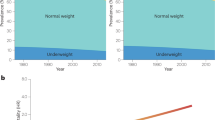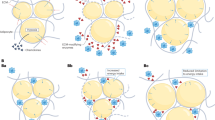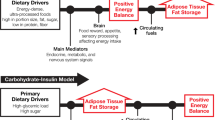Abstract
The prevalence of obesity is increasing worldwide, which indicates that the primary cause of obesity lies in environmental and behavioural changes rather than in genetic modifications. Among the environmental influences, the percentage of fat energy of the everyday diet and the lack of physical activity are two important factors, which contribute to explain the rising prevalence of obesity. In this review, several lines of evidence are presented to illustrate why dietary fat does affect obesity development. There are four factors which support a link between dietary fat and obesity development:
-
1
The thermic effect of nutrients, expressed as percentage of their energy content, is 2–3% for lipids, 6–8% for carbohydrates and 25–30% for proteins. This means that the efficiency of nutrient utilization (calculated as 100%—the thermic effect of the nutrient) is higher for fat than for carbohydrate or protein.
-
2
Postingestive fuel selection favours the oxidation of dietary proteins and carbohydrates, whereas dietary fats are preferentially stored as triacylglycerol in adipose tissue. Alcohol, by inhibiting lipid oxidation, indirectly favours the storage of dietary fats.
-
3
High-fat diet promotes excessive energy intake by passive overconsumption; the fat-induced appetite control signals are too weak or too delayed to prevent excessive energy intake from a fatty meal.
-
4
The only proof that dietary fats contribute to weight gain is to test the long-term effect of ad libitum low-fat diets. Most studies on low-fat diets show that they induce a modest weight loss in obese individuals, but their long-term effect from a public health perspective is limited, probably due to a low compliance to the dietary advice.
This is a preview of subscription content, access via your institution
Access options
Subscribe to this journal
Receive 12 print issues and online access
$259.00 per year
only $21.58 per issue
Buy this article
- Purchase on Springer Link
- Instant access to full article PDF
Prices may be subject to local taxes which are calculated during checkout
Similar content being viewed by others
Author information
Authors and Affiliations
Corresponding author
Rights and permissions
About this article
Cite this article
Jéquier, E. Pathways to obesity. Int J Obes 26 (Suppl 2), S12–S17 (2002). https://doi.org/10.1038/sj.ijo.0802123
Published:
Issue Date:
DOI: https://doi.org/10.1038/sj.ijo.0802123
Keywords
This article is cited by
-
High fat diet reveals sex-specific fecal and liver metabolic alterations in C57BL/6J obese mice
Metabolomics (2023)
-
The regulation of adipokines related to obesity and diabetes is sensitive to BDNF levels and adipose tissue location
Hormones (2022)
-
Characterization of metabolites and biomarkers for the probiotic effects of Clostridium cochlearium on high-fat diet-induced obese C57BL/6 mice
European Journal of Nutrition (2022)
-
Neuroendocrine microRNAs linked to energy homeostasis: future therapeutic potential
Pharmacological Reports (2022)
-
Estimating physical activity from self-reported behaviours in large-scale population studies using network harmonisation: findings from UK Biobank and associations with disease outcomes
International Journal of Behavioral Nutrition and Physical Activity (2020)



